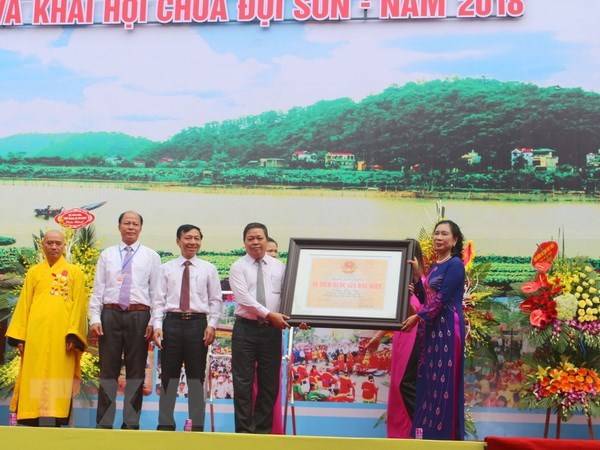
The People’s Committee of Ha Nam province hosted a ceremony on May 3 to receive a certificate recognizing Doi Son (or Long Doi Son) pagoda as a special national relic site and to kick off Doi Son pagoda festival 2018.
At the
ceremony (Source: VNA)
The Doi Son pagoda is located in Doi Son
commune, Duy Tien district, the Red River Delta province
of Ha Nam.
The pagoda was built in 1054 under the reign of King Ly Thanh Tong. It was
expanded from 1118-1121 under the reign of King Ly Nhan Tong along with the
construction of Sung Thien Dien Linh tower.
In the early 15th century, both Doi Son pagoda and Sung Thien Dien Linh tower
were completely destroyed when the Ming aggressors invaded the country. Under
the Later Le, Mac and Nguyen dynasties, the pagoda was rebuilt and its
architecture was gradually restored.
Speaking at the ceremony, Deputy Minister of Culture, Sports and Tourism Dang
Thi Bich Lien asked Ha Nam
province to work out an overall planning scheme for the long-term preservation
of the relic site.
The relic site management board should plant landmarks surrounding the pagoda,
promote the dissemination of information about its historical, cultural,
scientific and artistic values, build plans for restoration and upgrading and
maintain traditional festive rituals, she said.
The official also suggested the provincial authorities to uphold the values of
local typical festivals in a bid to further foster its tourism development.
Source: VNA
Hoa Binh province has carried out multiple programmes and initiatives to revive its cultural heritage which has gradually fallen into oblivion through the ebbs and flows of history.
The most prominent and defining feature in the prehistoric era of Hoa Binh is the Hoa Binh Culture. The Culture was first discovered in Hoa Binh. The significant prehistoric culture represents not only Vietnam but also Southeast Asia and southern China. Through excavations of cave sites in the limestone regions of Hoa Binh, French archaeologist M. Colani introduced the world to a "Stone Age in Hoa Binh province – Northern Vietnam" in 1927. On January 30, 1932, the First Congress of Far Eastern Prehistorians, held in Hanoi, officially recognised the Hoa Binh Culture.
Known as the "Land of Epic History”, Hoa Binh province, the gateway to Vietnam’s northwest, boasts a strategic location and a unique cultural tapestry woven by its ethnic minority communities.
The People's Committee of Luong Son District recently held a ceremony to receive the certificate recognizing Sau Communal House in Thanh Cao Commune as a provincial-level historical and cultural site.
Recognising the importance of cultural heritage preservation in protecting and promoting the value system of Vietnamese culture, and serving socio-economic development in the new period, Party committees and local administrations in Hoa Binh province have identified it as a key task in the cultural development strategy. The province has been making efforts in mobilising resources, creating consensus among people and engaging ethnic communities in preserving and promoting cultural identity.
Hoa Binh province has captured growing attention both domestically and internationally for its distinctive cultural heritage and rich history. Most notably, it has been renowned for its famous Hoa Binh culture, considered the cradle of ancient Vietnamese civilisation. Looking ahead to significant milestones in 2025 and the 140th anniversary of province establishment in 2026, Hoa Binh Newspaper presents a comprehensive overview of the province's development across economic, social, cultural, tourism, and security domains.



